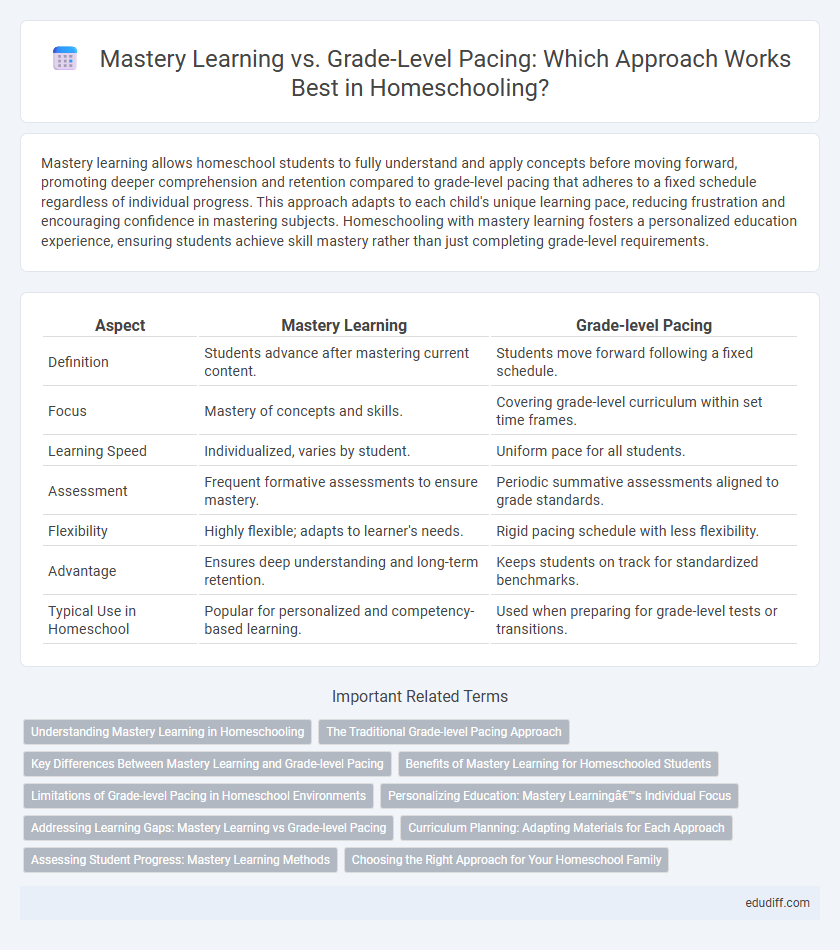Mastery learning allows homeschool students to fully understand and apply concepts before moving forward, promoting deeper comprehension and retention compared to grade-level pacing that adheres to a fixed schedule regardless of individual progress. This approach adapts to each child's unique learning pace, reducing frustration and encouraging confidence in mastering subjects. Homeschooling with mastery learning fosters a personalized education experience, ensuring students achieve skill mastery rather than just completing grade-level requirements.
Table of Comparison
| Aspect | Mastery Learning | Grade-level Pacing |
|---|---|---|
| Definition | Students advance after mastering current content. | Students move forward following a fixed schedule. |
| Focus | Mastery of concepts and skills. | Covering grade-level curriculum within set time frames. |
| Learning Speed | Individualized, varies by student. | Uniform pace for all students. |
| Assessment | Frequent formative assessments to ensure mastery. | Periodic summative assessments aligned to grade standards. |
| Flexibility | Highly flexible; adapts to learner's needs. | Rigid pacing schedule with less flexibility. |
| Advantage | Ensures deep understanding and long-term retention. | Keeps students on track for standardized benchmarks. |
| Typical Use in Homeschool | Popular for personalized and competency-based learning. | Used when preparing for grade-level tests or transitions. |
Understanding Mastery Learning in Homeschooling
Mastery learning in homeschooling emphasizes students achieving a deep understanding of concepts before progressing, contrasting with traditional grade-level pacing that follows fixed timelines. This approach allows customized instruction tailored to each child's learning speed and style, fostering stronger retention and confidence in subjects like math and reading. Research shows mastery learning can improve academic outcomes by reducing gaps in knowledge and promoting mastery at every stage of education.
The Traditional Grade-level Pacing Approach
The traditional grade-level pacing approach organizes curriculum into fixed timeframes, requiring students to complete specific topics within a school year regardless of individual understanding. This method emphasizes uniform progress, often prioritizing coverage over comprehension, which can challenge students who need more time to master concepts. In homeschooling, reliance on this approach may limit personalized learning opportunities, potentially hindering mastery and long-term retention.
Key Differences Between Mastery Learning and Grade-level Pacing
Mastery learning emphasizes student comprehension and skill acquisition, allowing learners to progress only after demonstrating full understanding of material, while grade-level pacing follows a fixed schedule aligned with chronological grade standards regardless of individual readiness. This personalized approach in mastery learning supports deeper knowledge retention and reduces gaps in learning, contrasting with grade-level pacing that often prioritizes curriculum coverage over mastery. Data from homeschool assessments show higher achievement and satisfaction rates when mastery learning is implemented, highlighting its effectiveness in accommodating diverse learning speeds.
Benefits of Mastery Learning for Homeschooled Students
Mastery learning allows homeschooled students to fully understand and retain concepts before advancing, ensuring a strong foundation in subjects. This approach accommodates individual learning speeds, reducing frustration and promoting confidence in students. It also fosters deeper critical thinking skills and personalized educational experiences that align with each learner's unique needs.
Limitations of Grade-level Pacing in Homeschool Environments
Grade-level pacing in homeschool environments often restricts personalized learning by enforcing uniform timelines that do not accommodate individual student's comprehension speeds or learning styles. This rigid structure can lead to gaps in mastery, as students may be pushed ahead without fully understanding foundational concepts, hindering long-term academic success. The lack of flexibility also diminishes the ability to tailor educational experiences to each learner's unique needs and interests, which is a core advantage of homeschooling.
Personalizing Education: Mastery Learning’s Individual Focus
Mastery learning in homeschooling emphasizes personalized education by allowing students to progress at their own pace until they fully understand a concept, contrasting with grade-level pacing that imposes uniform timelines. This individualized approach caters to each learner's strengths, ensuring deeper comprehension and retention before moving forward. Data shows that mastery learning can significantly improve academic outcomes by aligning instruction with student readiness rather than age or grade level.
Addressing Learning Gaps: Mastery Learning vs Grade-level Pacing
Mastery learning in homeschooling allows students to thoroughly understand concepts before moving forward, effectively addressing learning gaps by tailoring progress to individual comprehension. Grade-level pacing follows a fixed curriculum timeline, which can leave some students struggling to keep up or moving ahead without fully grasping material. Prioritizing mastery learning helps ensure foundational skills are solid, reducing long-term academic challenges and promoting deeper knowledge retention.
Curriculum Planning: Adapting Materials for Each Approach
Curriculum planning in homeschooling requires distinct strategies when choosing between mastery learning and grade-level pacing. Mastery learning emphasizes adapting materials to ensure students fully understand each concept before advancing, often necessitating personalized assessments and flexible lesson timelines. Grade-level pacing aligns curriculum with standardized benchmarks and rigid schedules, focusing on coverage of topics within set timeframes to meet typical grade progression.
Assessing Student Progress: Mastery Learning Methods
Mastery learning methods emphasize continuous assessment through formative evaluations that measure a student's understanding before progressing to new concepts. These assessments include personalized quizzes, performance tasks, and one-on-one feedback sessions, enabling tailored instruction based on individual mastery levels. This approach contrasts with traditional grade-level pacing, ensuring students achieve deep comprehension and skill proficiency prior to advancing.
Choosing the Right Approach for Your Homeschool Family
Mastery learning in homeschooling emphasizes personalized pacing, allowing students to fully understand concepts before progressing, which fosters deeper knowledge retention and confidence. Grade-level pacing follows a structured timeline aligned with traditional school standards, ensuring coverage of required curriculum within set periods. Selecting the right approach depends on your child's learning style, motivation, and family goals, balancing flexibility with academic benchmarks.
Mastery Learning vs Grade-level Pacing Infographic

 edudiff.com
edudiff.com